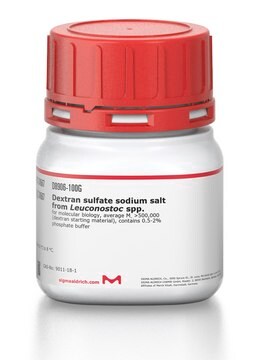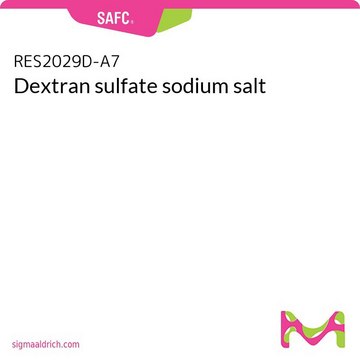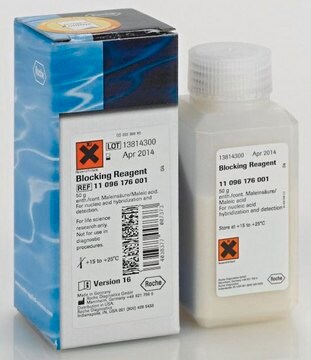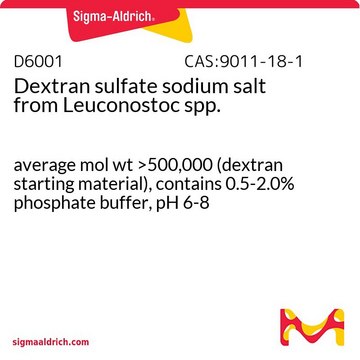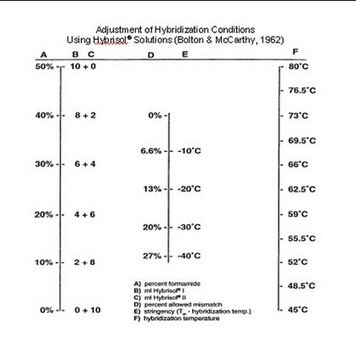67578
Dextran sulfate sodium salt
Synonym(s):
Dextran Sulfate Sodium
Sign Into View Organizational & Contract Pricing
All Photos(1)
About This Item
UNSPSC Code:
12352201
NACRES:
NA.25
Recommended Products
form
powder
Quality Level
loss
≤10% loss on drying
useful pH range
6.0-8.0 (10 g/L)
solubility
H2O: 100 mg/mL, clear, colorless to faintly greenish-yellow
storage temp.
room temp
Looking for similar products? Visit Product Comparison Guide
General description
Dextran is a polymer of anhydroglucose. It is composed of approximately 95% alpha-D-(166) linkages. The remaining (163) linkages account for the branching of dextran.
Application
Dextran sulfate is routinely used for the selective precipitation of lipoproteins, probe hybridization membrane-immobilized DNA, the release of DNA from DNA-histone complexes, and the inhibition of RNA binding to ribosomes.
Dextran sulfate is used as a diluent in in situ hybridization experiments to increase hybridization of probes to target sequences in tissues.
Other Notes
To gain a comprehensive understanding of our extensive range of Dextrans for your research, we encourage you to visit our Carbohydrates Category page.
Storage Class Code
11 - Combustible Solids
WGK
WGK 2
Flash Point(F)
Not applicable
Flash Point(C)
Not applicable
Choose from one of the most recent versions:
Already Own This Product?
Find documentation for the products that you have recently purchased in the Document Library.
Customers Also Viewed
The rate of nucleic acid annealing to cytological preparations is increased in the presence of dextran sulfate.
L L Lederman et al.
Analytical biochemistry, 117(1), 158-163 (1981-10-01)
Rodabe N Amaria et al.
Nature medicine, 24(11), 1649-1654 (2018-10-10)
Preclinical studies suggest that treatment with neoadjuvant immune checkpoint blockade is associated with enhanced survival and antigen-specific T cell responses compared with adjuvant treatment1; however, optimal regimens have not been defined. Here we report results from a randomized phase 2
Nadezhda V Petrova et al.
Cell cycle (Georgetown, Tex.), 15(3), 337-344 (2015-12-23)
Heat stress is one of the best-studied exogenous stress factors; however little is known about its delayed effects. Recently, we have shown that heat stress induces cellular senescence-like G2 arrest exclusively in early S-phase cells. The mechanism of this arrest
Sinah-Sophia Weiterer et al.
The EMBO journal, 39(1), e101533-e101533 (2019-11-09)
How cytokine-driven changes in chromatin topology are converted into gene regulatory circuits during inflammation still remains unclear. Here, we show that interleukin (IL)-1α induces acute and widespread changes in chromatin accessibility via the TAK1 kinase and NF-κB at regions that
Adél Sepsi et al.
Frontiers in plant science, 9, 1193-1193 (2018-08-30)
ImmunoFISH is a method combining immunolabelling (IL) with fluorescent in situ hybridisation (FISH) to simultaneously detect the nuclear distribution of proteins and specific DNA sequences within chromosomes. This approach is particularly important when analysing meiotic cell division where morphogenesis of
Our team of scientists has experience in all areas of research including Life Science, Material Science, Chemical Synthesis, Chromatography, Analytical and many others.
Contact Technical Service

